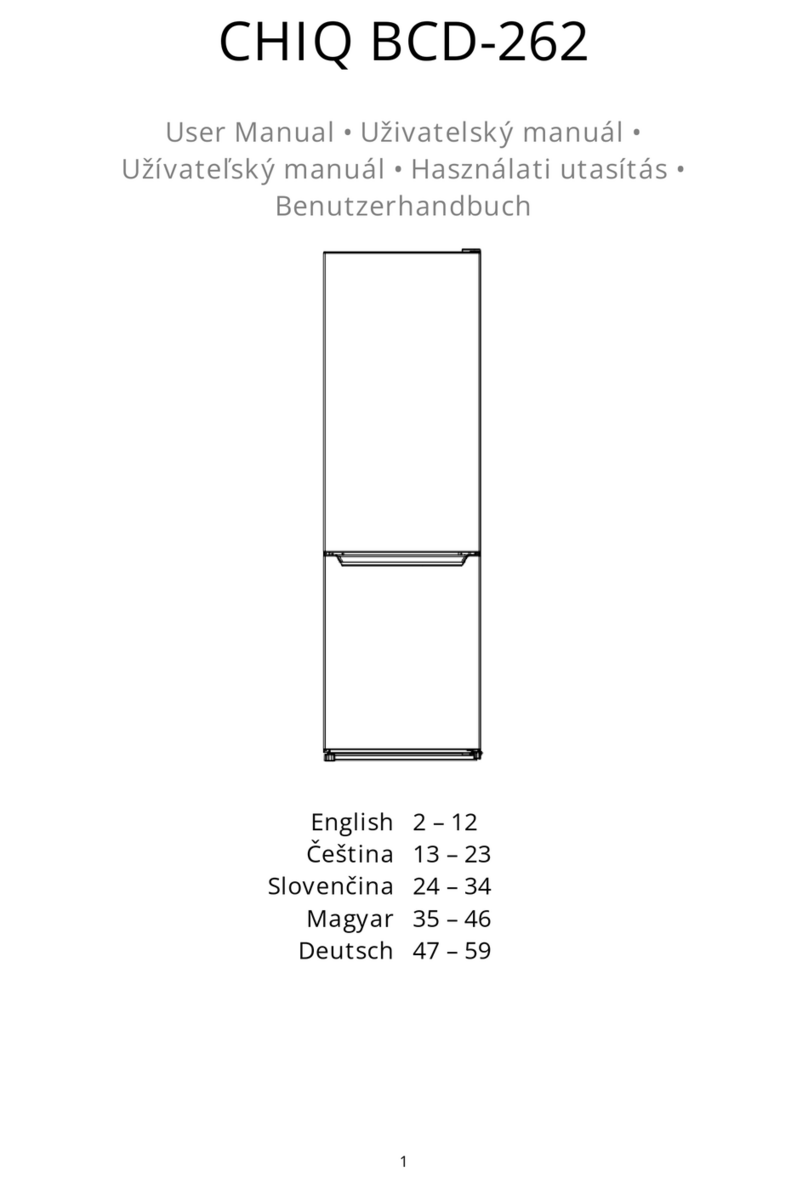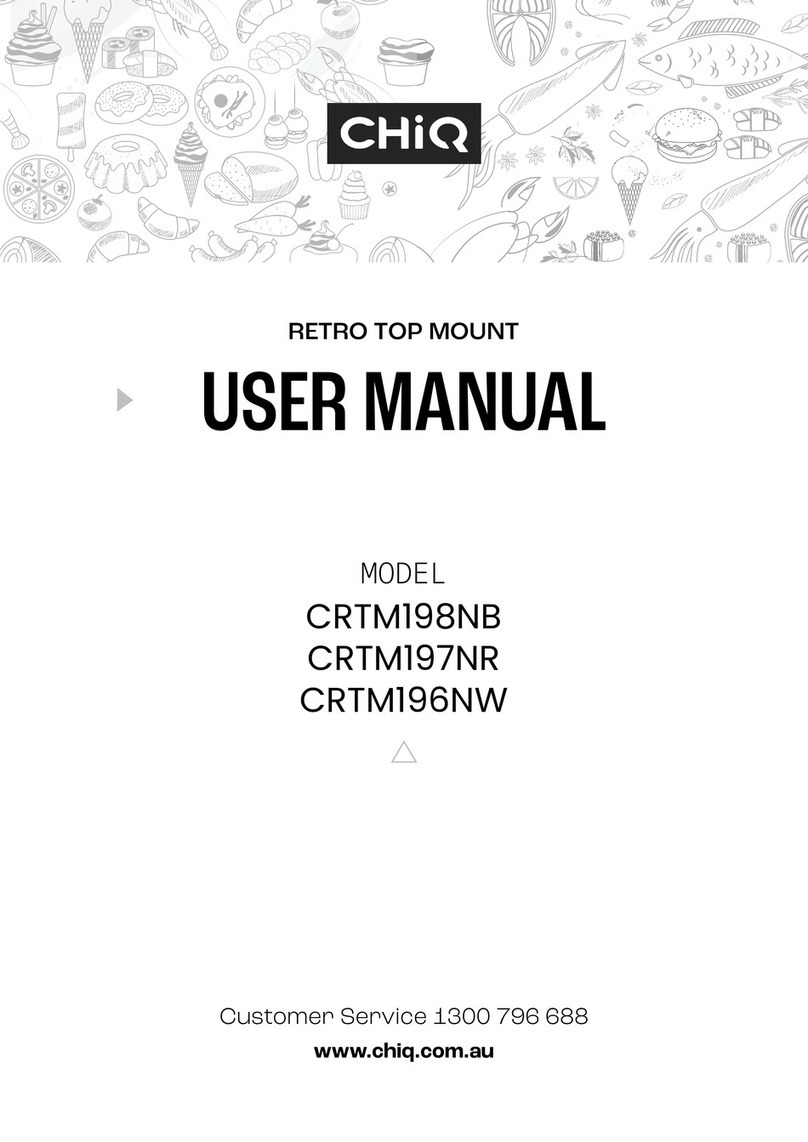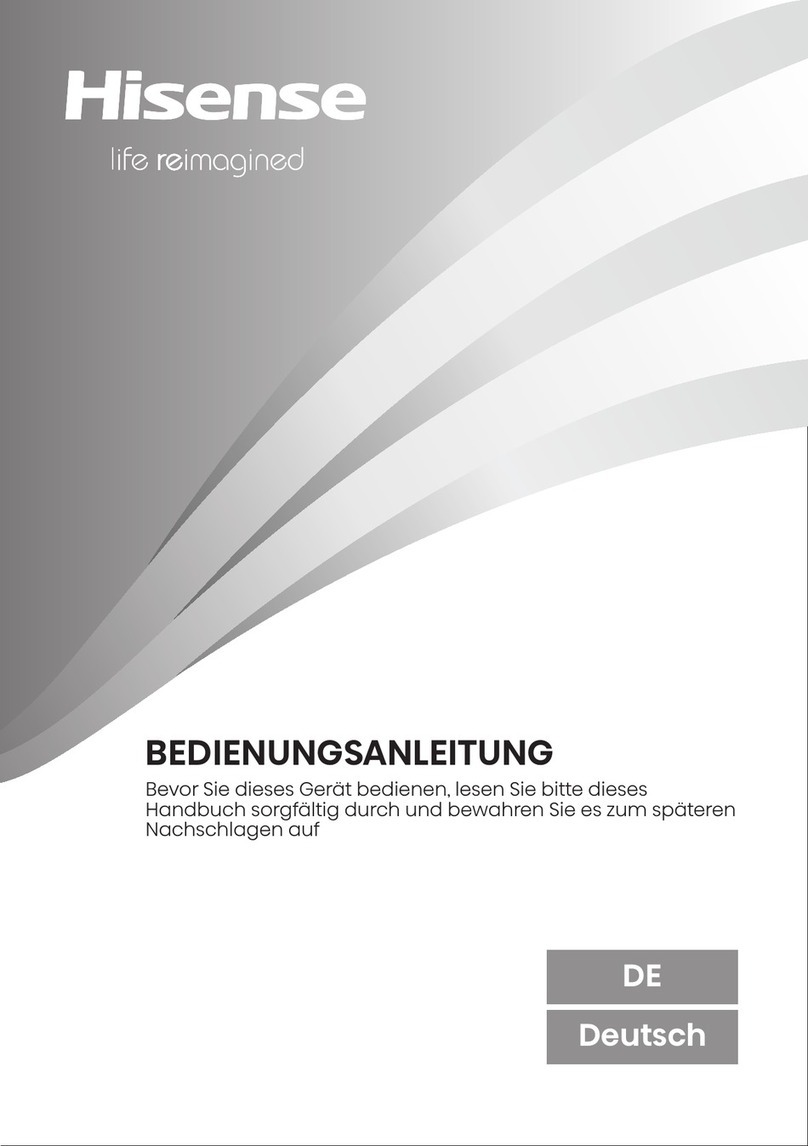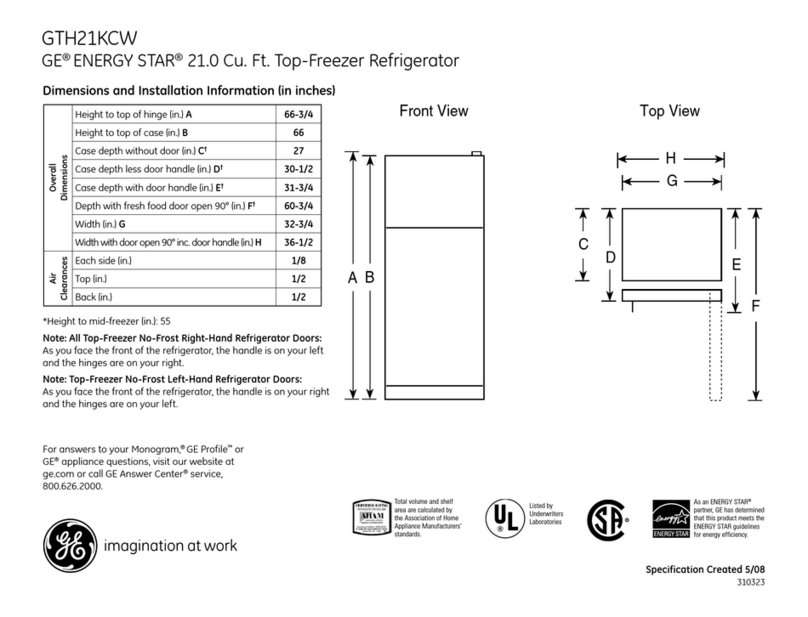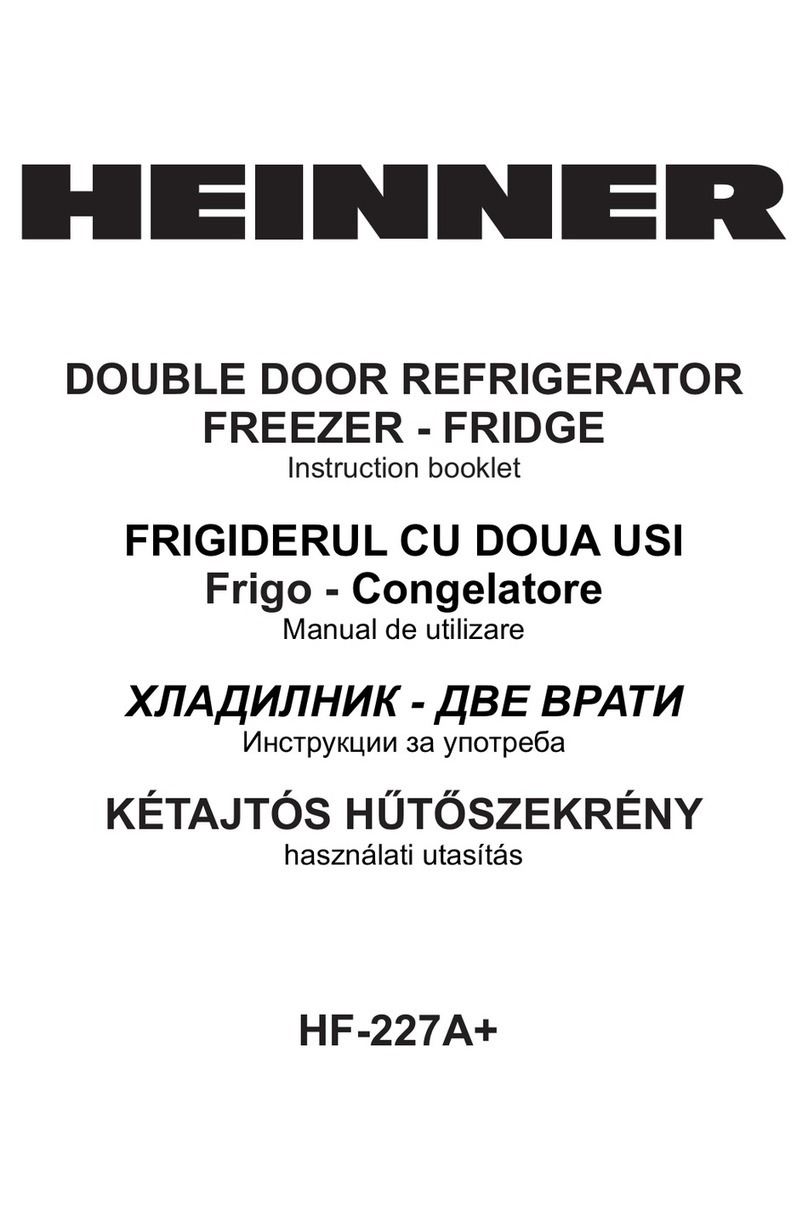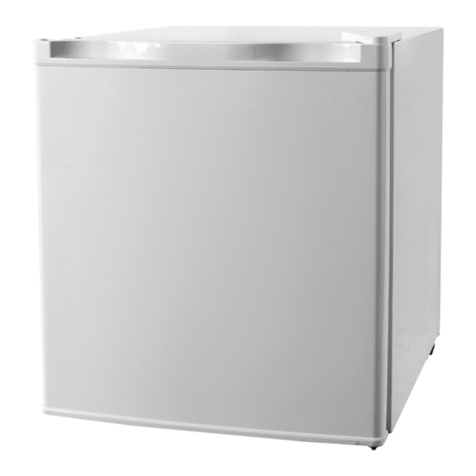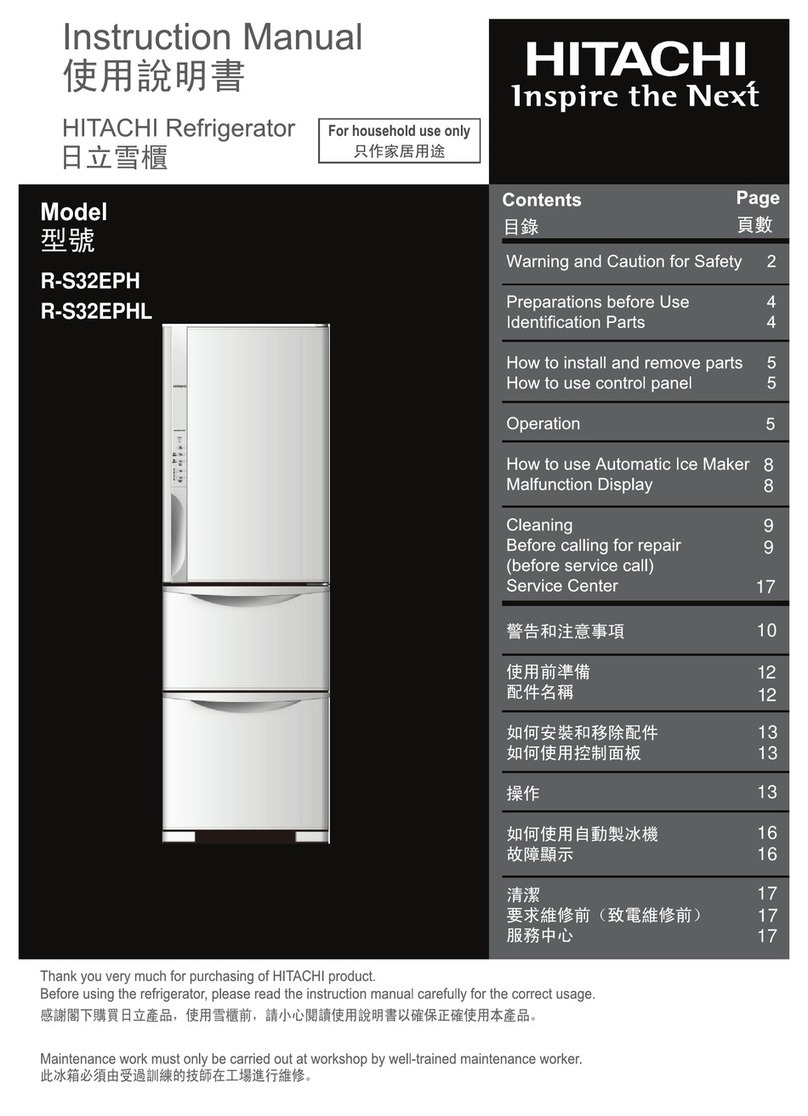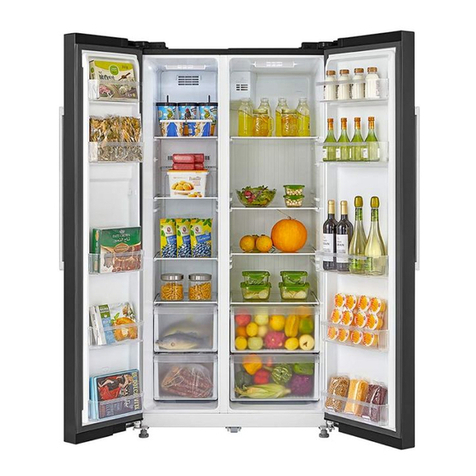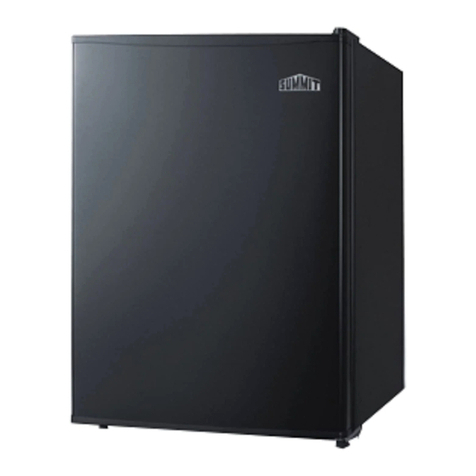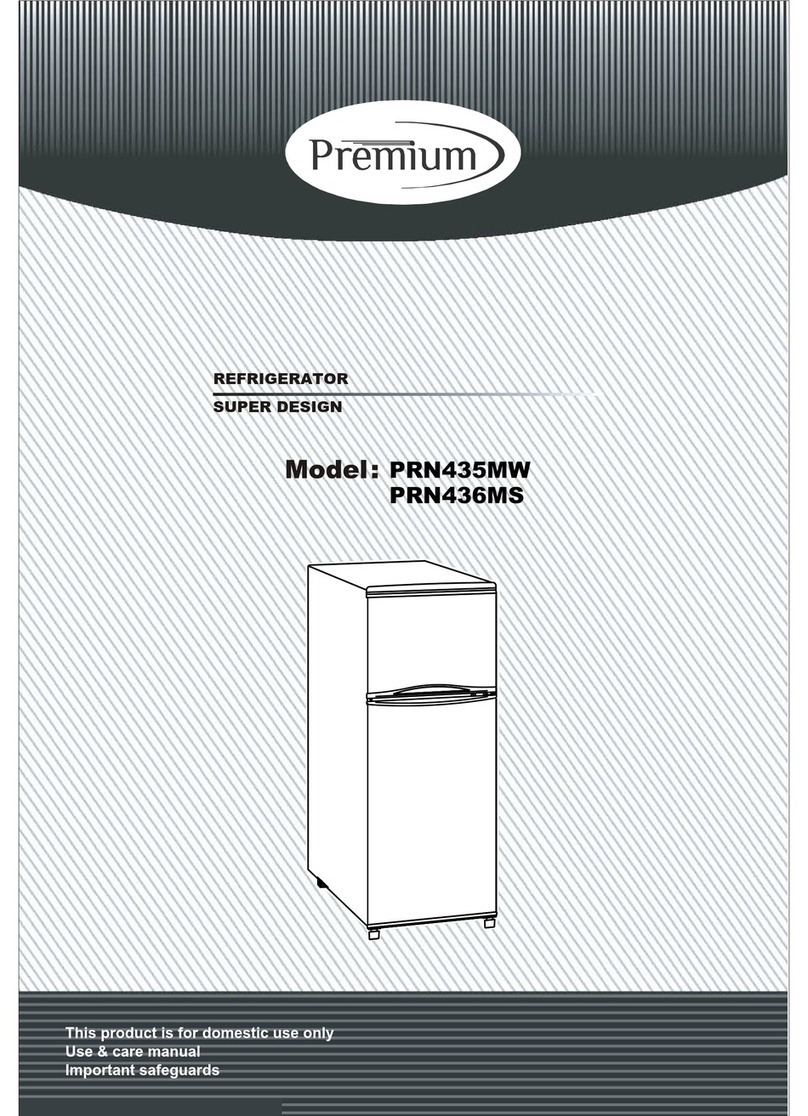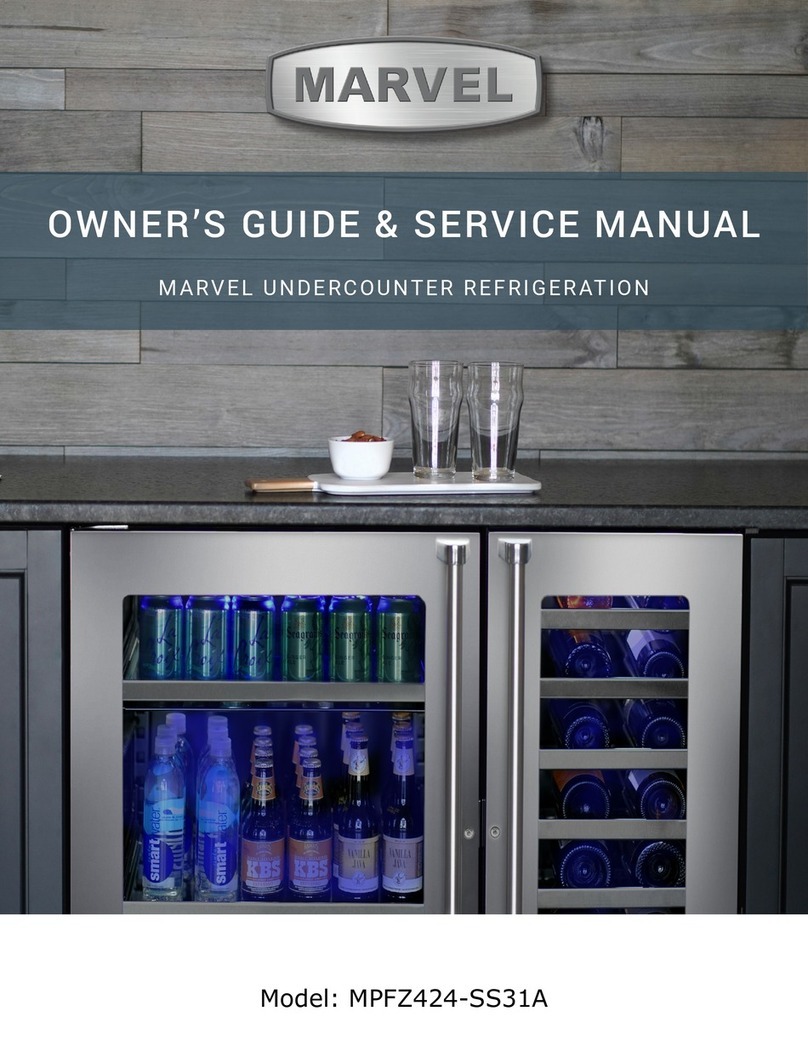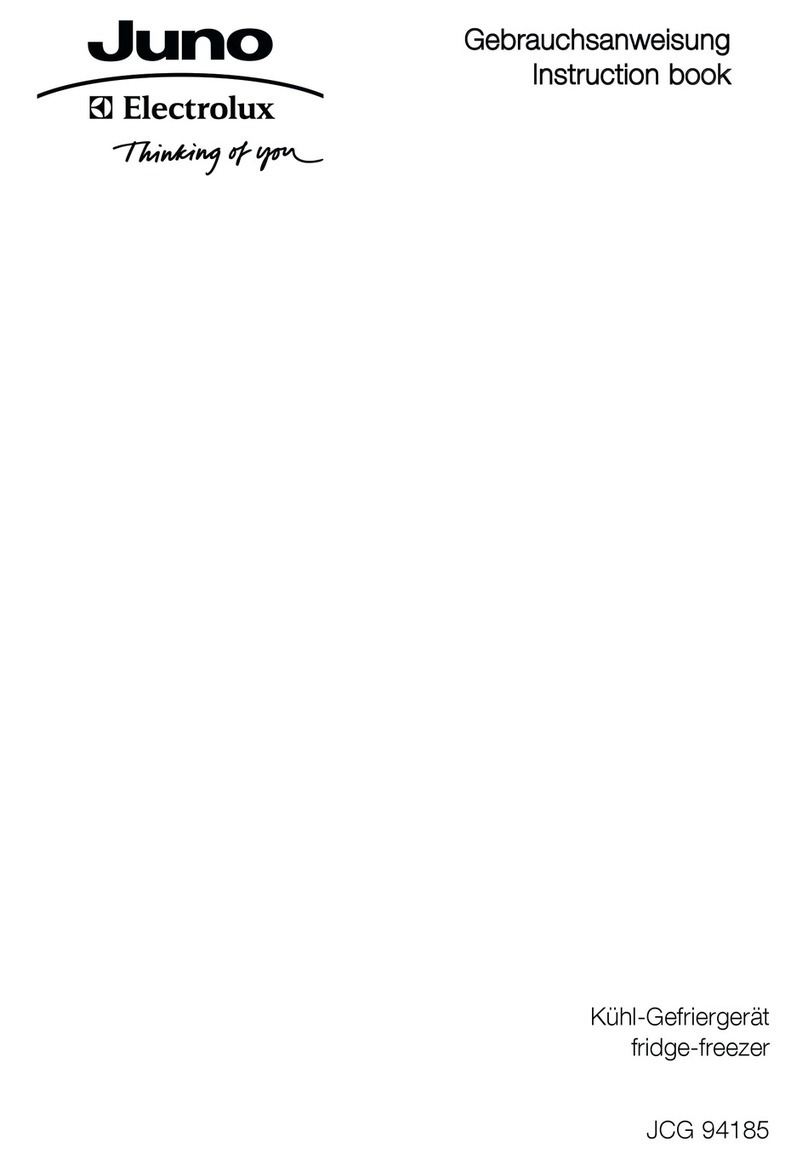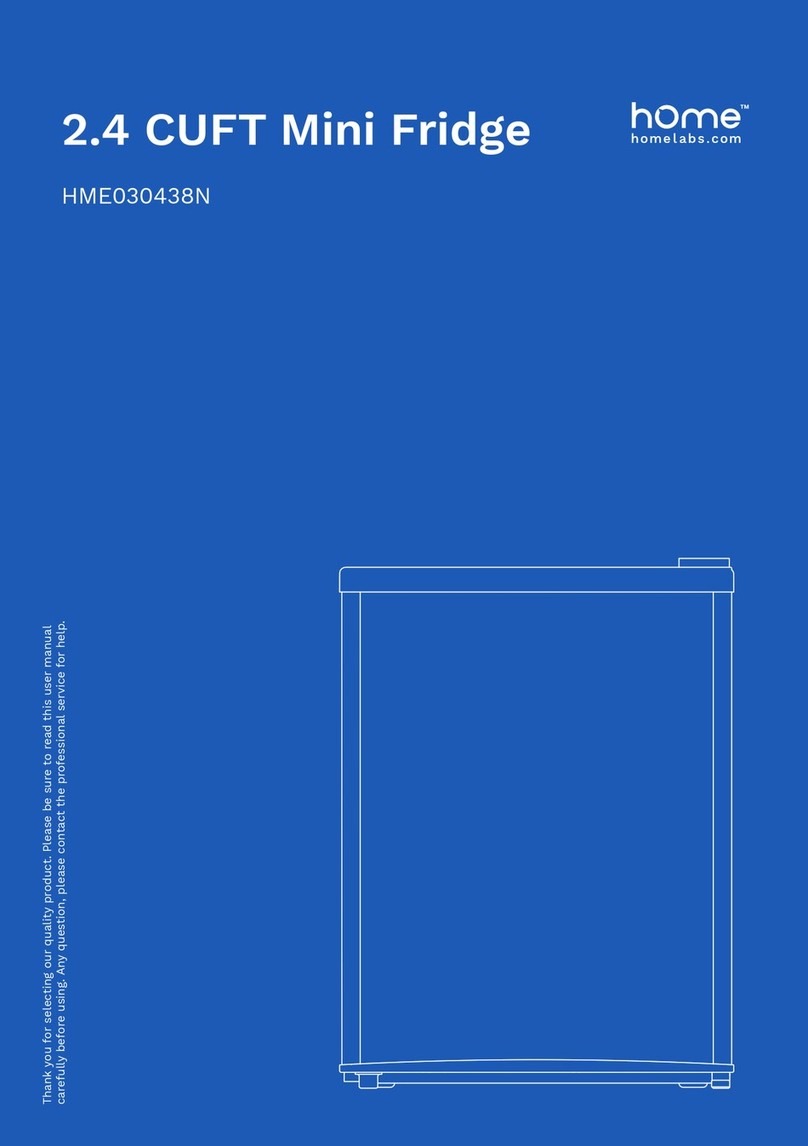ChiQ CTM400W User manual

USER MANUAL
FROST FREE
REFRIGERATOR
Keep this manual in a safe location and use it for reference.
Read this manual carefully before commencing operation of this appliance,
and comply with the Terms and Conditions.
CTM400W
www.chi
q
.com.au ENGLISH
CTM399S

1
PART NAMES AND LOCATIONS
1. PLASTIC FREEZER DOOR BINS 7. LAMP COVER
2. PLASTIC REFRIGERATOR DOOR BINS 8. REFRIGERATOR TEMPERED GLASS SHELVES
3. PLASTIC BOTTLE BIN 9. PLASTIC CRISPER COVER
4. METAL WIRE FREEZER SHELF 10. PLASTIC CRISPER
5. FREEZER TEMPERATURE CONTROL KNOB 11. FRONT LEVELING FEET
6. REFRIGERATOR TEMPERATURE CONTROL KNOB
12. ICE MAKER AND ICE TRAY (freezer section)
13. IN ACCESSORY BAG: USER MANUAL, EGG TRAYS, WARRANTY CARD AND DOOR STOPPER (small plastic
parts for door reverse purpose ONLY) .
As the manufacturer holds the authority to redesign or modify its products without notice:
Any modifications or upgrades of our products will result in this refrigerator varying slightly from this manual
but the functionality will remain the same to that as set out within this manual.

2
IMPORTANT SAFETY INSTRUCTIONS
WARNING
Follow these basic precautions to reduce the risk of fire,
electrical shock hazards or injury when operating the
refrigerator:
It is critical use this appliance safely. Read all instructions before operating the refrigerator
and do not attempt to repair or modify this unit in any way as it can cause harm or void the
warranty.
Please ensure all persons using this appliance are also informed and comply with the details
set out within this manual and the product Terms and Conditions.
When unpacking the appliance for the first time, keep all cardboard and plastic packaging
out of reach from children and report any notable defects with the appliance to Changhong
or retailer as soon as it is noted. Failure to do so can result in a non-warranty claim. Keep all
packaging materials in a safe location until the unit has been properly installed.
If the supplied power cord of this unit is damaged, it must be replaced by the manufacturer
or its service agent or similarly qualified persons in order to avoid any risk of injury. It is
recommended the power cord is situated in a safe location when operating or transporting
the appliance to prevent any damage that may cause electrical shock or fire hazards. DO
NOT unplug the appliance without switching the unit off from the outlet first or by yanking the
cord.
This appliance is intended to be used in a domestic household or similar applications such as:
- Staff areas in shops and offices, hotels, motels and other residential type environments;
- Catering and similar non-retail applications.
DANGER or WARNING: Risk of Child Entrapment.
If discarding this unit, follow these simple precautions:
- Remove the door/s from the unit.
- Leave the shelves in place so that children may not easily climb inside.
- Never allow children to operate, play with, or crawl inside the refrigerator.
- Children should be supervised near the unit at all times.
- This appliance is not intended for use by persons (including children) with reduced physical,
sensory or mental capabilities, or lack of experience and knowledge, unless they have been
given supervision or instruction concerning use of the appliance by persons responsible for
their safety.
- Only dispose of this appliance at an authorized waste disposal centre.
DANGER or WARNING: Ventilation Hazards
- Never clean the refrigerator or refrigerator parts with flammable fluids, or store gasoline or
any other flammable vapors and liquids in the vicinity of this or any other refrigerator as the
gas and/or vapour can cause a fire hazard, explosion or inhalation.
Electrical Connection
Make certain, when installing or moving the unit that the power outlet has been connected
to, has been fitted by a qualified electrician and the ground wire has been connected
properly to meet the Australian Electrical Standards.

3
INSTALLATION INSTRUCTIONS
Before Using the Refrigerator
Remove the exterior and interior packing.
Before connecting the refrigerator to a power source, let the unit stand upright for
approximately 4 hours to mitigate the possibility of a malfunction in the cooling system from
improper handling during transportation.
Clean the interior surface with lukewarm water using a soft cloth. (Refer to the cleaning
instruction on page 5)
Installing the Refrigerator
This appliance is designed to be free standing only, and should not be recessed or built-in.
Place the refrigerator on a leveled/even floor surface that is strong enough to support the
weight of the refrigerator when it is fully loaded to prevent vibrations and allow water to properly
drain.
The leveling feet should only be used in forward and backward motions and never side to side.
Allow at least 5cm of space between the back and sides of the refrigerator to allow
proper air ventilation. Adjust the two front feet to keep the refrigerator leveled or elevated.
Situate the refrigerator away from direct sunlight and sources of direct heat (stove, heater,
radiator, etc.). Direct sunlight may also affect the acrylic coating and heat sources may cause
an increase electrical consumption. Ambient temperature below 50°F or above 85°F will hinder
the performance of this appliance.
This unit is not designed for outside installation.
Avoid situating the refrigerator in moist OR pest infestation areas.
Plug the refrigerator into dedicated, properly installed-grounded wall outlet. Do not under any
circumstances cut or remove the third (ground) prong from the power cord. Any questions
concerning power and/or grounding should be directed toward a certified electrician or an
authorized service center.
After plugging the appliance into a wall outlet, turn the unit on and allow the unit to cool down
for 2~3 hours before placing food in the refrigerator or freezer compartment.
Do not place items on the top of this appliance.
ENERGY SAVING TIPS
Allow hot foods to cool to room temperature before placing in the refrigerator. Overloading the
refrigerator forces the compressor to work harder. Foods that freeze too slowly may lose
quality, or spoil.
Do not adjust the temperatures colder than necessary. Refer to page 4 for temperature
instructions.
Be sure to wrap foods properly, and wipe containers dry before placing them in the refrigerator.
This cuts down on frost build-up inside the refrigerator.
Organize and label food to reduce door openings and extended searches. Remove as many
items as needed at one time, and close the door as soon as possible.
Refrain from leaving the door/s open for a long time to conserve energy.

4
OPERATING THE REFRIGERATOR COMPARTMENT
Temperature Control
The refrigerator has one control for regulating the
temperature. The temperature control is located on the top
left hand corner of the refrigerator compartment.
The first time the unit has been switched on, adjust the
temperature control knob to “MAX” and run for at least 2
hours before putting foods inside. This will ensure the
cabinet is thoroughly chilled before your food is stored.
The range of the REFRIGERATOR temperature control is
from position "MIN" the warmest to "MAX" the coldest.
Adjust the temperature control to the setting that best suits
your needs.
NOTE:
- Adjusting the temperature control in the refrigerator compartment will impact the
temperature in both the refrigerator and the freezer compartments.
- If the unit is unplugged or loses power, please wait approximately 3 to 5 minutes before
restarting the unit. If there is any attempt to restart before this time delay, the refrigerator
will not commence operation.
- Large quantities of food stored in the appliance or directly in front of the air vent will hinder
the cooling efficiency of the appliance as this can affect the airflow.
- If you choose to change the thermostat settings in the fridge compartment, adjust the
thermostat control by one increment at a time.
- Allow 24 hours for temperature to stabilize between adjustments. Do not keep opening and
closing the door once increasing the temperature.
Please note different sections of refrigerator compartment may be warmer or
cooler than others – typically the back wall and bottom lowest shelf will be the
coolest, the top door shelf will be the warmest. To avoid frost bite, please don’t
put raw vegetables too close to the coolest area.

5
OPERATING THE FREEZER COMPARTMENT
Temperature Control
The freezer compartment has one control for regulating the
temperature and is located on the center of the freezer on the
interior back panel.
The range of the FREEZER temperature control is from
position "MIN" the warmest to "MAX" the coldest.
Optimum position for the airflow control in freezer is the
“MID” position. But it can be adjusted to the setting that best
suits your needs.
NOTE:
This compartment is designed for the long-term storage of frozen foods ONLY. Do not store
canned foods or food stored in glass containers in the freezer compartment.
The storage durations of frozen foods is up to three months as it varies on the products and
the recommended storage time should not be exceeded.
Place frozen food into the freezer as quickly as possible after purchase to prevent thawing. If
there are instructions on the packet, carefully follow these instructions regarding storage times
and temperatures.
WARNING: Never touch the interior of the freezer or frozen foods in the
compartment with wet hands while the unit is operating as this could result in frost bite.

6
CHANGING THE LIGHT GLOBE
Before removing the light bulb:
First turn off the refrigerator and then unplug the unit from the
wall outlet. (Failure to do so could result in electrical
shock or personal injury)
Use Phillips screwdriver to take out screw.
Remove the light cover by pulling downwards gently.
Unscrew the bulb.
Replace with a max 15 watt-refrigerator bulb that is the same
shape and size.
Replace the light bulb cover and tighten screw to secure back into place.
GENERAL CARE AND MAINTENANCE
Cleaning the Refrigerator
Upon installation of your new appliance, it is recommended that it be cleaned thoroughly and
properly maintained thereafter.
Turn off the refrigerator and then unplug the unit from the wall outlet.
Remove all food content before washing the inside with a damp cloth soaked in lukewarm
water and baking soda solution. The solution should be about 2 tablespoons of baking soda to
a litre of water.
Be sure to keep the door gasket (seal) clean to keep the unit running efficiently as improper
cleaning can cause the seal to dislodge and tear.
The exterior of the refrigerator should be cleaned with mild detergent and warm water. (door
and side of the units only.
Dry the interior and exterior with a soft cloth.
The condenser coils should be vacuumed when they are dusty or dirty. The condenser is an
internal tube, non-serviceable.
Don’t need to remove the water tray above compressor to empty water that will be evaporated
by heat from compressor.
Vacation Time
Turn off the refrigerator first and then unplug the unit from the wall outlet.
Remove all food.
Clean the refrigerator.
Leave the lid open slightly to avoid possible formation of condensation, mold, or odors.
Use extreme caution in the case of children. The unit should not be accessible to child’s play.
Short vacations: Leave the refrigerator operating during vacations of less than three weeks.
Long vacations: If the appliance will not be used for several months, remove all food and
unplug the power cord. Clean and dry the interior thoroughly. To prevent odour and mold
growth, leave the door open slightly: blocking it open if necessary or have the door removed.

7
Repositioning and Relocating the Refrigerator
Turn off the refrigerator first and then unplug the unit from the wall outlet.
Remove all the food and drinks.
Securely tape down all loose items inside your refrigerator.
Tape the doors shut.
Be sure the refrigerator stays in the upright position during transportation.
TROUBLESHOOTING GUIDE
Many common refrigerator problems can be easily, saving you the cost of a possible service call.
Try the suggestions below to see if you can solve the problem before calling for service.
PROBLEM
POSSIBLE CAUSES
Refrigerator does not operate.
Power cord isn’t plugged in properly.
The circuit breaker tripped or a blown fuse.
The light is not working.
The light bulb may be damaged. Refer to page 5 on how to
change the globe.
Compressor runs all the time
The room temperature is hotter than normal.
A large amount of food has been added to the refrigerator.
The door is opened too often.
The door is not closed completely.
The temperature control is not set correctly.
The door gasket does not seal properly.
The refrigerator does not have the correct clearances.
The refrigerator has recently been disconnected for a period of
time. 4+ hours are required for the refrigerator to cool down
completely pending on operating conditions.
Temperature inside the
refrigerator is too warm.
Temperature control is set incorrectly. Turn the control to a
cooler setting and allow several hours for the temperature to
stabilize.
Freezer control incorrectly set. Set back to mid position.
Door is kept open too long or is opened too frequently. Warm
air enters the refrigerator every time the door is opened). Open
the door less often.
The door is not closed completely.
The door gasket does not seal properly.
A large amount of warm or hot food might have been stored
recently. Wait until the refrigerator has had a chance to reach
its selected temperature.
The refrigerator has recently been disconnected for a period of
time. 4 hours is required for the refrigerator to cool down
completely.

8
Temperature inside the
refrigerator is too cold.
Freezer control incorrectly set. Set back to mid position.
Temperature control is set too cold. Turn the control to a
warmer setting and allow several hours for the temperature to
stabilize.
Temperature of external
refrigerator surface is warm.
The exterior refrigerator walls can be as much as 30F warmer
than room temperature. This is normal while the compressor
works to transfer heat from inside the refrigerator cabinet.
Popping or cracking sound
when compressor comes on.
Metal parts undergo expansion and contraction, as in hot water
pipes. This is normal. Sound will level off or disappear as
refrigerator continues to run.
Bubbling or gurgling sound,
like water boiling.
Refrigerant (used to cool refrigerator) is circulating throughout
the system. This is normal operation.
Vibrations.
Check the refrigerator is on a level/even surface.
Floor is uneven or weak. Refrigerator rocks on the floor when it
is moved slightly. Be sure floor can adequately support
refrigerator.
Level the refrigerator by putting wood or metal shims under
part of the refrigerator.
The refrigerator is touching the wall. Re-level the refrigerator
and move it from the wall. See “Installation Instructions”.
Moisture forms on inside
refrigerator walls.
Weather is hot and humid, which increases internal rate of frost
build-up. This is normal.
Door is slightly open.
Door is kept open too long, or is opened too frequently. Open
the door less often.
The door is not sealed properly.
Moisture forms on outside of
refrigerator.
Door is slightly open, causing cold air from inside the
refrigerator to meet warm moist air from the outside.
The door/s will not close
properly.
The refrigerator is not on a level surface.
The gasket/s may be dirty or not properly maintained. Clean
the seals and make sure they are dry before closing the door/s.
The storage basket and/or shelves are out of position.
For any enquiries, please call the CHiQ Cusotmer care on: 1300 796 688.
This manual suits for next models
1
Table of contents
Other ChiQ Refrigerator manuals

ChiQ
ChiQ CRTM198NB User manual
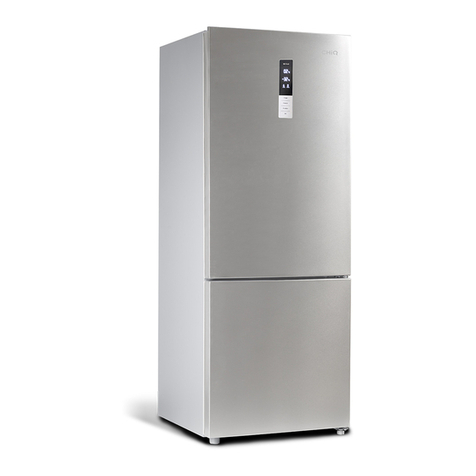
ChiQ
ChiQ CBM432W User manual
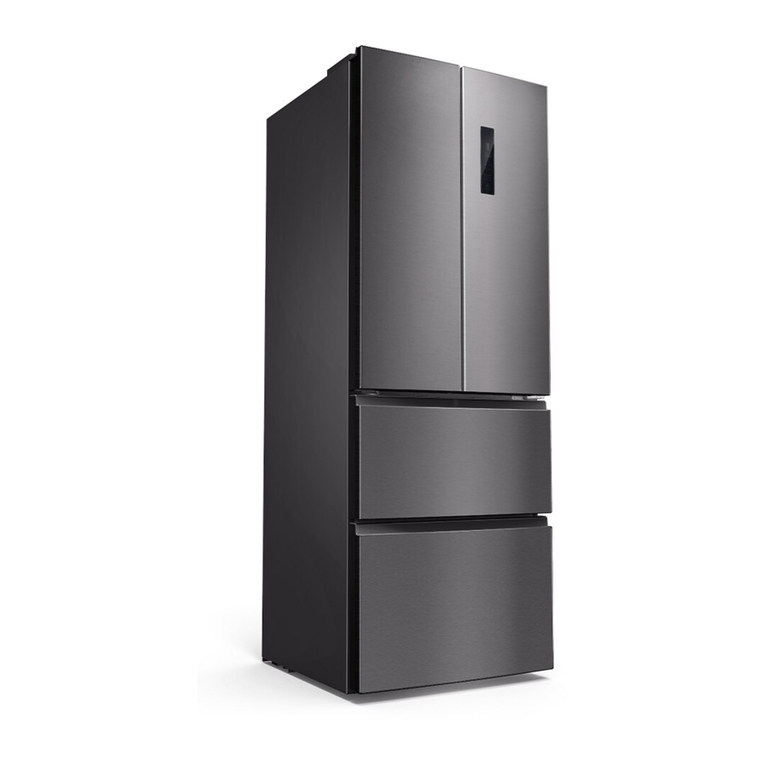
ChiQ
ChiQ CFD337NEI42 User manual

ChiQ
ChiQ MRF-262 User manual

ChiQ
ChiQ CQRB09Y1GD1RW User manual
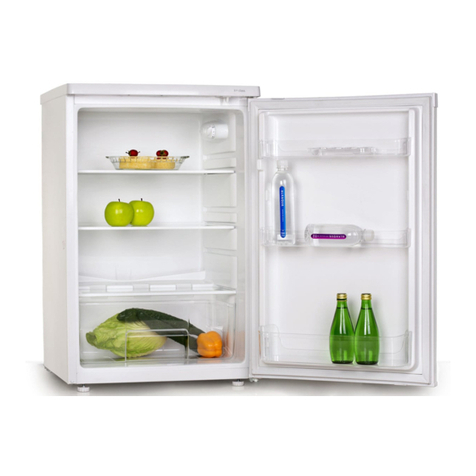
ChiQ
ChiQ CSR129W User manual

ChiQ
ChiQ MRF-252WE User manual
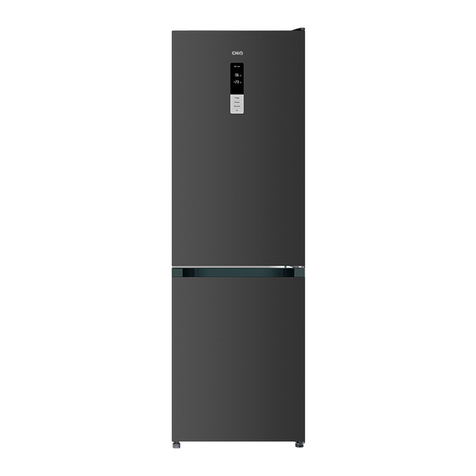
ChiQ
ChiQ FBM317NE4 User manual
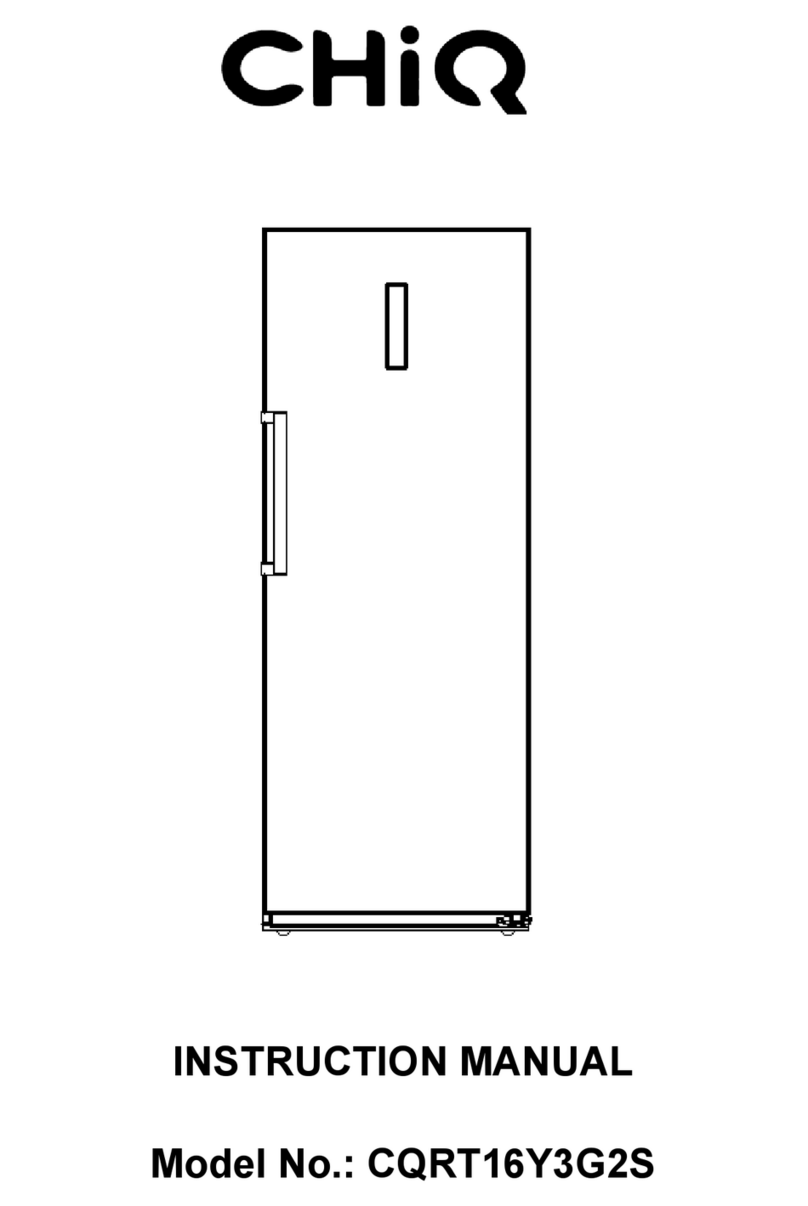
ChiQ
ChiQ CQRT16Y3G2S User manual

ChiQ
ChiQ CSS602WD User manual

ChiQ
ChiQ CQRT10Y1GD1W User manual

ChiQ
ChiQ FCD418NE3 User manual
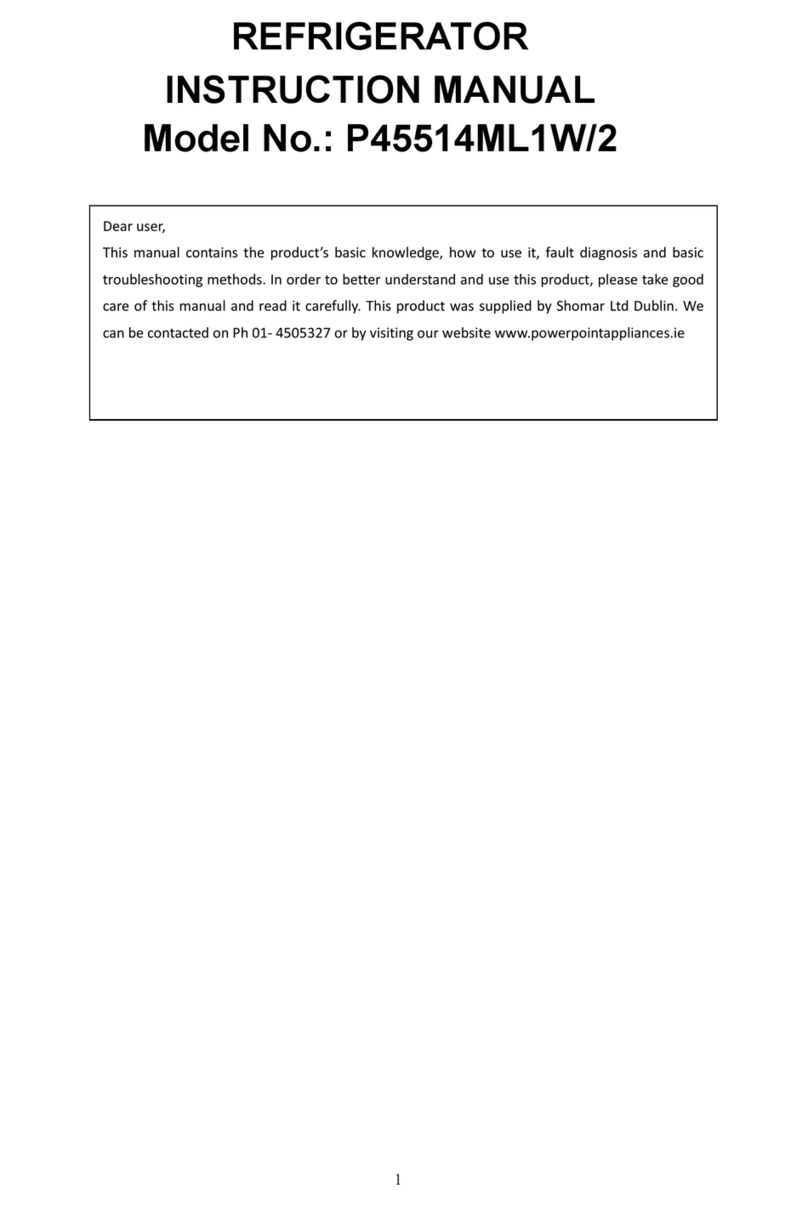
ChiQ
ChiQ P45514ML1W/2 User manual
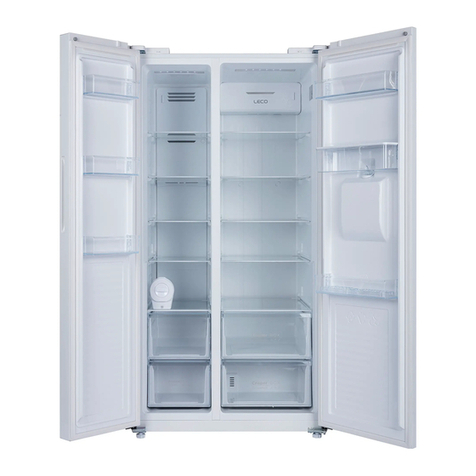
ChiQ
ChiQ MRF-630W User manual
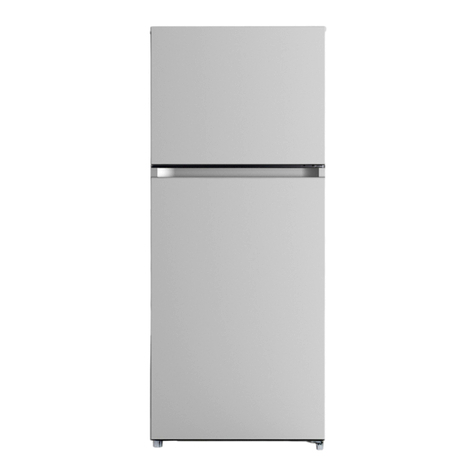
ChiQ
ChiQ CQRT12Y1GD1W User manual
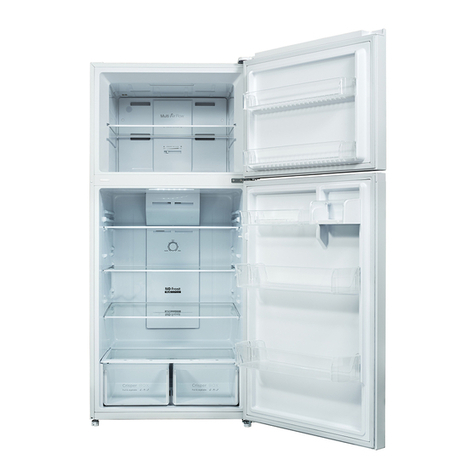
ChiQ
ChiQ CTM550W User manual
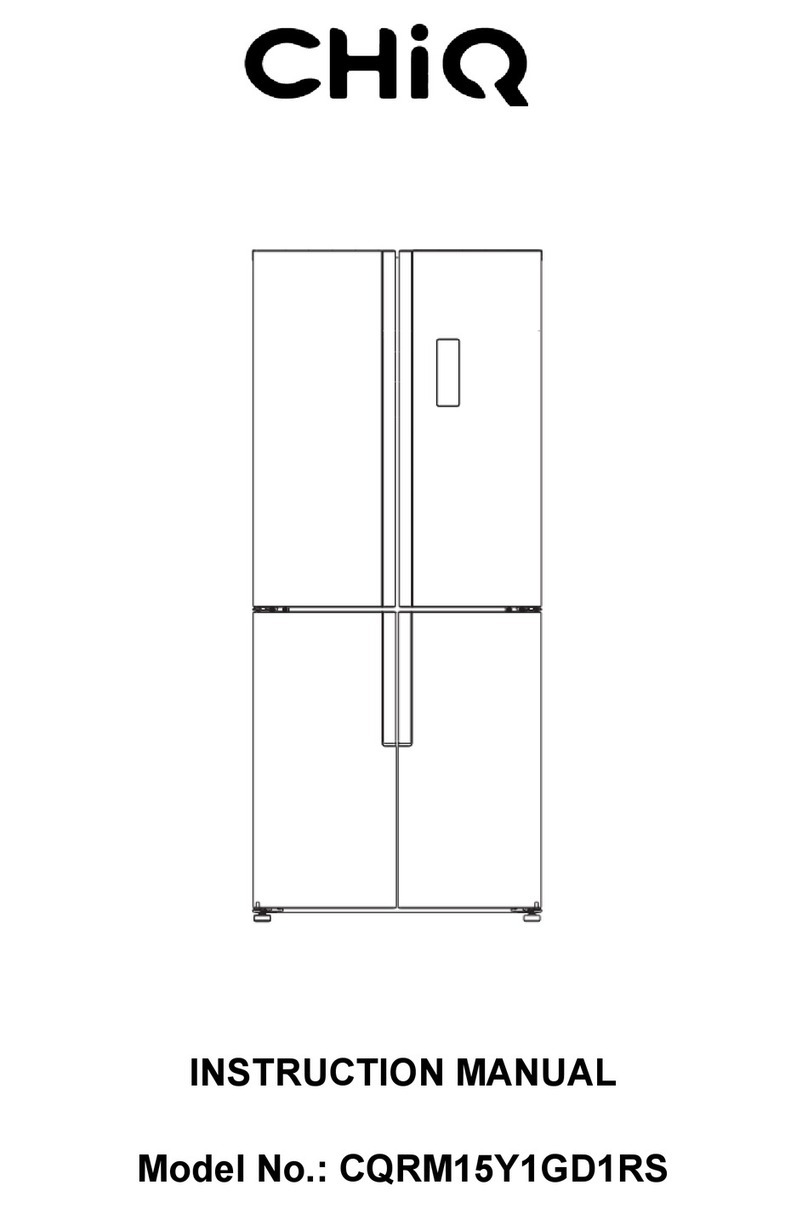
ChiQ
ChiQ CQRM15Y1GD1RS User manual

ChiQ
ChiQ CQRT04Z1GD1 User manual
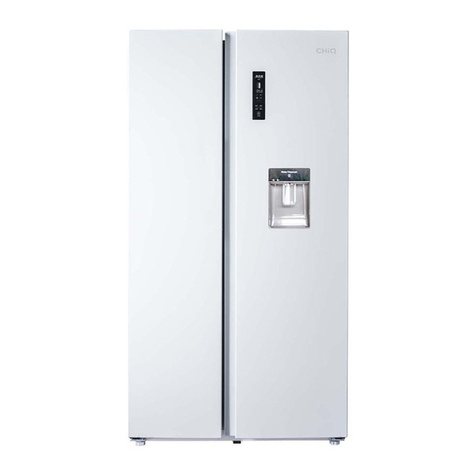
ChiQ
ChiQ CSS559NWD User manual
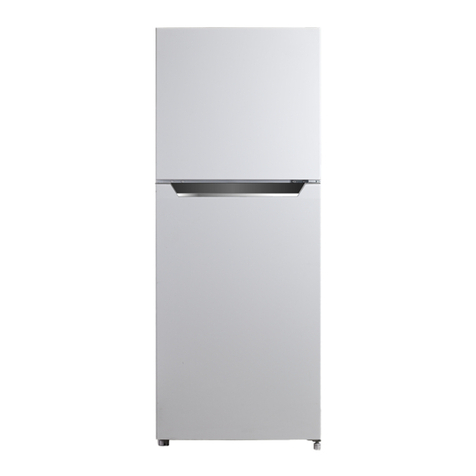
ChiQ
ChiQ CQRT07Z1GD1 User manual
